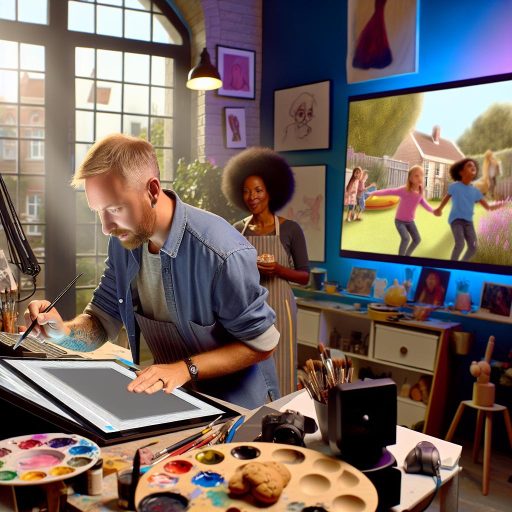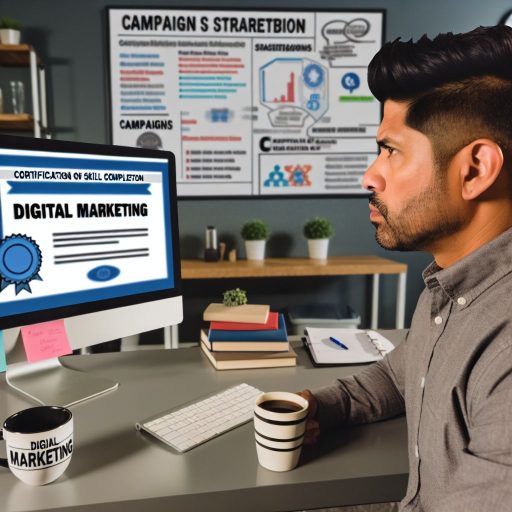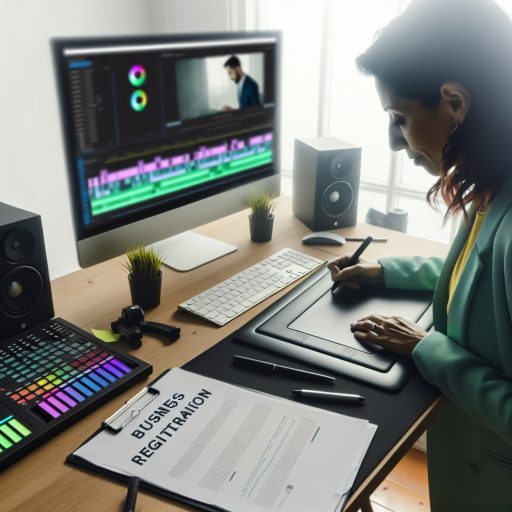Introduction
Art directors play a vital role in the creative industry.
They oversee the visual aspects of projects, guiding teams toward a unified vision.
Their work spans advertising, film, and publications, among others.
To succeed, art directors must balance creativity with practicality.
They must coordinate with various departments and manage budgets effectively.
Defining the Role of an Art Director
An art director shapes a project’s aesthetic direction.
They select color palettes, typography, and imagery that align with the brand’s identity.
They lead design teams, providing mentorship and constructive feedback.
Additionally, they collaborate with clients to understand their vision and needs.
An art director also ensures that the final product reflects the intended message and quality standards.
The Importance of Software Tools in Art Direction
Software tools empower art directors to bring their visions to life efficiently.
These tools facilitate collaboration among team members, enhancing communication.
They streamline repetitive tasks, allowing directors to focus on creativity.
Moreover, powerful design software enables quick visual iterations and adjustments.
Art directors can experiment with various styles without significant time investment.
Additionally, presentation tools help art directors pitch ideas effectively to clients.
They can create visually engaging presentations that convey their concepts clearly.
Project management software assists in organizing deadlines and resources, maintaining workflow efficiency.
By utilizing these tools, art directors can reduce errors and enhance productivity.
In a fast-paced industry, staying updated on design tools proves essential.
Transform Your Career Today
Unlock a personalized career strategy that drives real results. Get tailored advice and a roadmap designed just for you.
Start NowEmbracing new technologies helps art directors remain competitive.
It allows them to adapt to changing trends and client demands.
Ultimately, the right software tools signify a commitment to quality and excellence in art direction.
When it comes to essential software tools for art directors, few suites compare to Adobe Creative Suite.
This comprehensive collection of programs serves as the backbone for countless creative projects.
Art directors can create stunning visuals, effective layouts, and cohesive designs by mastering these applications.
Below, we explore the primary programs included in the Adobe Creative Suite and how art directors can utilize each tool effectively.
Overview of the Adobe Creative Suite Programs
Adobe Creative Suite includes several powerful programs that cater to various creative needs.
Here’s a breakdown of the key components:
- Adobe Photoshop
- Adobe Illustrator
- Adobe InDesign
- Adobe After Effects
- Adobe Acrobat
- Adobe Lightroom
Each of these tools offers unique features and capabilities that art directors rely on to execute their vision.
Understanding how each program works is essential for effective project management.
Adobe Photoshop
Photoshop is the most recognized image editing software globally.
Art directors often employ it for:
- Photo Editing: Enhance images through retouching, color correction, and filters.
- Compositing: Merge multiple images into a single cohesive piece, creating simulated realities.
- Creating Mockups: Develop realistic prototypes for presentations or client approvals.
Photoshop’s rich set of tools provides endless possibilities for artists and designers alike.
With features like layers, masks, and blending modes, art directors can manipulate graphics artistically and professionally.
Adobe Illustrator
Illustrator is essential for vector graphics and illustration.
Its core functions include:
- Creating Logos: Design scalable logos that maintain quality across different sizes.
- Graphic Design: Furnish artwork for packaging, posters, and marketing materials.
- Typography: Craft custom fonts and typographic compositions aimed at unique branding.
Using Illustrator, art directors can create exquisite visual content with precision.
This program excels in producing sharp, clean images that stand out, making it a favorite among branding professionals.
Adobe InDesign
InDesign is the go-to tool for layout design.
Transform Your Career Today
Unlock a personalized career strategy that drives real results. Get tailored advice and a roadmap designed just for you.
Start NowIt facilitates effective communication among text and visuals.
Here’s how art directors use InDesign:
- Page Layouts: Design brochures, magazines, and books with multi-page layouts.
- Multimedia Integration: Embed interactive elements such as videos and hyperlinks.
- Publication Design: Collaborate easily with printers and other professionals by exporting files in various formats.
With InDesign, art directors achieve cohesive design across multiple pages.
The software allows for versatile typography control, which maximizes the visual impact of written content.
Adobe After Effects
For projects that require animation and motion graphics, After Effects shines.
Art directors leverage it for:
- Animated Graphics: Create engaging video content using dynamic animations and effects.
- Visual Effects: Integrate special effects into video projects to enhance storytelling.
- Motion Tracking: Add layers of motion to static images, providing depth and interest.
Integrating After Effects into projects allows art directors to add an extra layer of creativity.
The visual appeal of a moving graphic often exceeds static images, captivating audience attention.
Adobe Acrobat
Acrobat serves as an essential tool for document management.
Art directors engage with Acrobat for:
- PDF Creation: Ensure documents retain formatting across devices and platforms.
- Collaboration: Share and review documents seamlessly with team members and clients.
- Signing Documents: Use e-signatures to streamline project approvals.
Acrobat’s functionality aids in file organization and enhances workflow efficiency.
It guarantees clarity in communication, an integral aspect of any artistic endeavor.
Adobe Lightroom
Lightroom specializes in photo management and editing, perfect for photographers.
Art directors utilize Lightroom for:
- Batch Processing: Edit multiple images simultaneously for consistent style and quality.
- Organizing Photos: Manage extensive photo libraries with tagging and collection features.
- Advanced Editing: Use robust tools for color correction and exposure adjustments.
Lightroom complements Photoshop, allowing art directors to optimize their photographic work efficiently.
The ease of use fosters a smoother creative process and enhances final visuals.
Art Directors and Technology
Adobe Creative Suite is indispensable for art directors aiming to excel in the creative field.
Each program fits a specific purpose, contributing to a final product that meets professional standards.
By mastering these tools, art directors can execute their artistic vision with precision and flair.
The skills acquired through these programs translate into compelling visuals that communicate effectively and resonate with audiences.
Transform Your Career Today
Unlock a personalized career strategy that drives real results. Get tailored advice and a roadmap designed just for you.
Start NowAs technology evolves, staying updated with these features is crucial.
Continuous learning ensures that art directors can adapt and innovate, ultimately leading to creative excellence.
Art directors play a critical role in shaping the visual identity of projects.
One of the most essential tools in their arsenal is Sketch.
This design software has become a favorite among UI/UX designers for its intuitive interface and powerful features.
Description of Sketch and Its Features
Sketch is a vector graphics editor tailored for web and mobile UI/UX design.
It offers a range of features specifically designed for quick and efficient prototyping.
Here’s a closer look at Sketch’s main attributes:
- Vector Editing: Sketch allows for scalable designs without losing quality. This is especially important for responsive designs.
- Symbols: Designers can create reusable components. This feature helps maintain consistency across projects.
- Artboards: Users can create multiple artboards for different screens. This is useful for developing various device interfaces simultaneously.
- Plugins: The Sketch community provides numerous plugins. These plugins extend capabilities and streamline the design process.
- Collaboration Tools: Real-time collaboration features enable team members to work together. This fosters better communication and quicker iterations.
- Export Options: Designers can export assets easily. This supports various file formats needed for development and presentation.
Utilizing Sketch for Creating Wireframes, Mockups, and Prototypes
The versatility of Sketch makes it a powerful tool for art directors.
They can utilize it to create wireframes, mockups, and prototypes effectively.
Here’s how:
Creating Wireframes
Wireframes are essential in outlining project layouts.
They provide a visual guide that can help stakeholders understand design flow.
To create wireframes in Sketch:
- Start with Basic Shapes: Use rectangles, lines, and text tools to sketch the initial layout. This helps define areas for navigation, content, and buttons.
- Use Symbols for Repeated Elements: Design common elements as symbols. This can include buttons, headers, and footers.
- Take Advantage of Artboards: Create separate artboards for different screens. This is useful for each step in the user journey.
- Adjust Opacity and Color: Use low contrast colors to indicate wireframe states. Different shades can represent different layers of content.
- Iterate Based on Feedback: Share the wireframe with stakeholders to gather input. Use that feedback to make quick adjustments.
Designing Mockups
Once the wireframes are approved, art directors can create detailed mockups.
Mockups provide a more polished view of how the final product will look.
Here’s the process:
- Import Images and Icons: Use high-quality images and icons. This enhances the visual appeal of the mockup.
- Apply Color Schemes: Choose a color palette that reflects the brand identity. Use different shades throughout the design.
- Utilize Text Styles: Establish typographic hierarchy using consistent font styles. This helps guide the user’s attention appropriately.
- Use Grids and Layouts: Implement grid systems to align elements. This ensures a balanced overall composition.
- Iterate and Adjust: Continue refining the design based on team input and usability tests. This will enhance the user experience.
Prototyping
Prototyping is the final step in the design process before development.
It allows stakeholders to interact with the design.
Here’s how art directors can leverage Sketch for prototyping:
Transform Your Career Today
Unlock a personalized career strategy that drives real results. Get tailored advice and a roadmap designed just for you.
Start Now- Create Interactive Elements: Add links and hotspots to buttons and menus. This simulates user interaction and navigation.
- Use the Preview Feature: Utilize Sketch’s built-in preview mode to test transitions and interactions. This helps visualize the user experience.
- Share with Stakeholders: Export prototypes for review or share them using Sketch’s collaboration features. This fosters timely feedback.
- Gather User Testing Feedback: Conduct tests with real users to collect feedback on usability. Refine the prototype based on user insights.
- Export for Development: Once the prototype is polished, export the assets for developers. This streamlines the transition from design to development.
Art directors should embrace Sketch to enhance their workflow and create outstanding designs.
By fully utilizing its capabilities, they can produce high-quality projects that resonate with both users and stakeholders.
This not only reinforces their design efficiency but also contributes to the overall success of their projects.
Explore Further: Understanding SEO Fundamentals for Web Designers
Overview of Cinema 4D as a 3D Modeling and Animation Software
Cinema 4D is a powerful software used for 3D modeling, animation, and rendering.
Developed by Maxon, it has become a tool of choice for many artists and designers.
Its user-friendly interface allows both beginners and experienced users to create stunning visuals.
This software supports a wide range of applications, including motion graphics, architectural visualization, and game design.
With its robust set of tools, Cinema 4D enables users to bring their creative visions to life.
Key features of Cinema 4D include:
- Intuitive User Interface: The layout is clean and customizable, making navigation easy.
- Advanced Modeling Tools: Features include polygon modeling, sculpting, and parametric objects.
- Powerful Animation Capabilities: It offers various animation techniques like keyframing and motion tracking.
- Realistic Rendering: The physical render engine produces high-quality results with realistic lighting and textures.
- Integration with Other Software: Cinema 4D works seamlessly with popular applications like After Effects and Photoshop.
How Art Directors Can Incorporate 3D Elements into Their Projects Using Cinema 4D
Art directors frequently integrate 3D elements into various projects.
Cinema 4D provides numerous tools and features that streamline this process.
Below, we discuss how art directors can effectively incorporate 3D elements in their workflow.
Enhance Visual Storytelling
Art directors can use Cinema 4D to enhance visual storytelling in a project.
By integrating 3D models, they create immersive experiences.
This approach captures the audience’s attention and deepens engagement.
For example, an art director working on a promotional video can:
- Create 3D logos and text that stand out.
- Simulate product environments or scenarios.
- Animate characters to provide movement and excitement.
Build Realistic Environments
Creating realistic environments is crucial for many projects.
Cinema 4D excels in producing intricate landscapes and settings.
Art directors can craft virtual worlds tailored to specific narratives.
Transform Your Career Today
Unlock a personalized career strategy that drives real results. Get tailored advice and a roadmap designed just for you.
Start NowThe 3D modeling capabilities offer significant advantages:
- Art directors can design detailed landscapes with terrain tools.
- They can incorporate architectural elements with precision.
- Every aspect, from lighting to textures, can be finely tuned to enhance realism.
Collaborate with 3D Artists
Art directors often work alongside 3D artists.
Cinema 4D simplifies communication between team members.
The software’s layered file structure allows for easy project sharing and collaboration.
Project management becomes more efficient when:
- Directors can quickly review and provide feedback on 3D assets.
- Team members understand the creative vision through shared files.
- Revisions are easily implemented with the intuitive interface.
Experiment with Motion Graphics
Cinema 4D is renowned for its motion graphic capabilities.
Art directors can create animated sequences that captivate viewers.
These animated graphics uplift promotional materials and enhance storytelling.
Art directors can use motion graphics in several ways:
- Animate logos to make dynamic brand introductions.
- Create transitions that smoothly evolve between scenes.
- Integrate 3D text elements that add depth to presentations.
Use Plugins for Extended Functionality
Cinema 4D supports numerous plugins that enhance its functionality.
Art directors can customize their tools based on project needs.
Using plugins expands the creative possibilities significantly.
Some popular plugins include:
- Octane Render: For real-time rendering and photorealistic imagery.
- X-Particles: For advanced particle effects and simulations.
- Greyscalegorilla Tools: For enhancing the rendering and animation workflow.
Create Engaging Marketing Content
3D elements in marketing content grab attention and increase engagement.
Art directors can develop stunning visuals for advertisements using Cinema 4D.
By employing 3D design, they convey messages more effectively.
Marketing campaigns can benefit from 3D design in various forms:
- Product visualizations that highlight features.
- Infographics that visually represent data.
- Animated promotional videos that capture viewer interest.
Showcase Architectural Designs
Cinema 4D is a powerful tool for architects and designers.
Art directors can visualize architectural designs in 3D effectively.
Presenting designs in a realistic format improves client understanding.
Transform Your Career Today
Unlock a personalized career strategy that drives real results. Get tailored advice and a roadmap designed just for you.
Start NowExamples of architectural uses include:
- Creating walk-through animations to demonstrate concepts.
- Visualizing building interiors with realistic lighting.
- Generating detailed exterior renderings for marketing purposes.
Incorporating 3D elements into projects enhances creativity and engagement.
Cinema 4D provides a versatile platform for art directors to explore these possibilities.
From motion graphics to architectural visualization, the software empowers directors to push boundaries.
Art directors should continually explore Cinema 4D’s capabilities, enabling them to create compelling visuals.
Leveraging these tools will undoubtedly elevate any project, capturing the audience’s imagination.
Find Out More: Best Social Media Platforms for Influencer Relations
Benefits of Procreate for Digital Illustration and Painting
Procreate offers a suite of tools designed for artists of all skill levels.
Here are some of the standout benefits:
- User-Friendly Interface: Procreate’s layout allows for easy navigation.
- Powerful Brushes: The app offers a vast library of brushes.
- High-Resolution Canvases: Procreate supports incredibly high-resolution canvases.
- Layer Management: The layering system allows for complex compositions.
- Real-Time Performance: Procreate offers swift performance without lag.
- Animation Features: Users can create simple animations directly within Procreate.
- Export Options: Procreate provides multiple export formats.
- Accessibility: Available on the iPad, Procreate is portable.
Using Procreate for Hand-Drawn Elements
Art directors can significantly benefit from incorporating Procreate into their workflows.
The app facilitates the creation of unique, hand-drawn elements that add personality to projects.
1. Sketching Concepts
Procreate allows art directors to sketch initial concepts quickly.
They can experiment with ideas without needing expensive materials.
Here are some advantages of sketching in Procreate:
- Speed: Rapid sketching lets directors visualize ideas quickly.
- Flexibility: The ability to easily erase and alter sketches enhances experimentation.
- Organizational Tools: Layers help keep ideas organized during the creative process.
2. Custom Brushes and Textures
Art directors can create custom brushes tailored to their style.
Creating unique textures elevates the overall aesthetic of the artwork.
The following steps guide art directors in this process:
- Explore Brush Settings: Customizing stroke settings leads to unique brush behavior.
- Create Textures: Export textures as PNG files, then import them as brushes.
- Save Presets: Save custom brushes for future projects to maintain consistency.
3. Creating Detailed Illustrations
Procreate’s high-resolution capabilities enable detailed illustrations.
Art directors can focus on intricate designs that capture the viewer’s attention.
Consider these techniques:
Transform Your Career Today
Unlock a personalized career strategy that drives real results. Get tailored advice and a roadmap designed just for you.
Start Now- Zooming In: Use the zoom feature to work on fine details comfortably.
- Layer Adjustments: Utilize layers to manage different elements separately.
- Color Palette: Create and save custom color palettes for cohesive artwork.
4. Integrating with Other Software
Procreate integrates seamlessly with other software tools.
This capability simplifies the overall workflow for art directors.
Here are some ways to optimize this integration:
- Exporting Files: Save artworks in formats compatible with Photoshop and Illustrator.
- Using Cloud Storage: Sync files to cloud services for easy access across devices.
- Collaboration Tools: Use shared files to get feedback from team members in real time.
5. Adding Personal Touches
Hand-drawn elements add a personal touch to projects.
Art directors can derive unique designs that distinguish their work.
Consider implementing the following strategies:
- Handwritten Text: Use Procreate’s text tools to create custom typography.
- Personal Marks: Incorporate unique symbols that represent the project’s essence.
- Dynamic Elements: Experiment with scale and orientation to achieve balance.
6. Presenting Ideas to Clients
A well-crafted presentation can impress clients.
Procreate helps art directors create visually appealing pitches.
Keep these tips in mind for effective presentations:
- Case Studies: Develop case studies with visuals to showcase the project’s evolution.
- Mockups: Use Procreate to create mockups that visualize the final product.
- Animations: Incorporate simple animations to engage clients and illustrate concepts.
Procreate as a Vital Digital Tool
Procreate revolutionizes the way art directors approach digital illustration and painting.
Its extensive toolset, intuitive design, and portability make it an essential software for the creative process.
From sketching concepts to creating detailed illustrations, Procreate facilitates the entire workflow.
By harnessing its robust features, art directors can create memorable visuals that resonate with clients.
Embracing Procreate enhances their productivity and elevates creative expression.
In the fast-paced world of design, having the right tools is crucial.
Procreate stands out as a valuable asset in any art director’s toolkit.
You Might Also Like: Freelance vs. In-house Communications Consultant Roles

Introduction to Project Management Tool Asana
Asana is a powerful project management tool designed to improve team collaboration and productivity.
It focuses on organizing work and streamlining tasks.
Art directors benefit significantly from using Asana in their creative processes.
Transform Your Career Today
Unlock a personalized career strategy that drives real results. Get tailored advice and a roadmap designed just for you.
Start NowThis tool helps manage projects efficiently while ensuring that every team member stays aligned.
Here’s a closer look at its features and how art directors can implement Asana in their daily routines.
How Art Directors Can Use Asana to Organize Tasks
Art directors juggle multiple tasks and projects simultaneously.
Asana simplifies task management with its intuitive interface.
Here are several ways art directors can utilize Asana:
- Creating Projects: Art directors can create a new project for each campaign.
- Task Assignment: They can break down projects into specific tasks.
- Setting Deadlines: Directors can set clear deadlines for each task.
- Adding Details: Asana allows adding attachments and descriptions for tasks.
- Organizing Tasks: Art directors can prioritize tasks using Asana’s different views.
Collaborating with Team Members
Collaboration is crucial in creative projects.
Asana enhances communication among team members.
Here are some collaboration features that art directors can exploit:
- Comments Section: Each task has a comments section for discussions.
- Tagging Team Members: Directors can tag colleagues in comments.
- File Attachments: Asana allows users to attach files to tasks.
- Integration with Other Tools: Asana integrates with tools like Google Drive and Dropbox.
- Team Dashboards: Art directors can create dashboards to visualize project statuses.
Meeting Deadlines Effectively
Meeting deadlines is essential in the fast-paced world of art and design.
Asana offers several functionalities that help art directors stay on schedule:
- Timeline View: The timeline feature visualizes project schedules.
- Progress Tracking: Team members can update task statuses in real-time.
- Recurring Tasks: For ongoing projects, directors can set recurring tasks.
- Milestones: Setting milestones within a project can mark critical points of progress.
- Reports and Analytics: Asana provides insights into project performance.
Customizing Workflows in Asana
Every team has unique workflows.
Asana allows art directors to customize their project management processes:
- Custom Fields: Art directors can add custom fields for specific needs.
- Templates: Creating templates for recurring projects saves time.
- Rules Automation: Asana enables automating repetitive actions.
- Integrating with Other Apps: By integrating with apps like Slack or Zoom, art directors can enhance communication.
- Personalized Notifications: Team members can customize their notification settings.
Fostering Creativity with Asana
Creative processes thrive on inspiration and collaboration.
Asana supports creativity in numerous ways:
- Brainstorming Sessions: Directors can create tasks for brainstorming ideas.
- Feedback Loops: The comments section allows for iterative feedback.
- Collaboration on Design Projects: Team members can collaborate on visual content using file attachments.
- Visual Workflows: Asana’s board view visualizes work in a Kanban style.
- Running Creative Workshops: Directors can organize workshops by creating dedicated projects.
Streamlining Project Management for Art Directors
Asana has become an essential tool for art directors.
It streamlines project management and enhances team collaboration.
By organizing tasks effectively, fostering efficient communication, and meeting deadlines, directors can focus on their creative vision.
Customizable workflows allow adaptability to each team’s needs.
With these tools, art directors can lead their teams toward successful project completions.
Embracing Asana empowers teams to create their best work with structure and creativity.
Transform Your Career Today
Unlock a personalized career strategy that drives real results. Get tailored advice and a roadmap designed just for you.
Start NowExplore Further: Tips for Creating a Memorable Radio Show Intro
Importance of Software Tools in Art Direction
In the dynamic world of art direction, software tools play a crucial role.
They not only streamline workflows but also empower creativity.
By providing various functionalities, these tools help art directors visualize concepts effectively.
They enhance collaboration, allowing teams to share ideas seamlessly.
With the right software, an art director can transform their vision into reality.
Utilizing software tools boosts productivity and saves time.
An efficient tool can automate repetitive tasks, permitting more focus on creativity.
High-quality design tools enable precise image editing and graphic creation.
Additionally, project management software keeps projects on track and promotes effective teamwork.
In this ever-evolving field, having the right tools is essential.
Art directors should recognize the diverse range of software options available.
With so many choices, it’s imperative to experiment with various tools.
Different projects may require unique functionalities, so finding the right fit is vital.
Trying out different design and management platforms helps identify what suits individual or team needs best.
As technology advances, new tools emerge, offering innovative features and improvements.
Staying informed about the latest developments can significantly benefit an art director’s workflow.
Regularly exploring new software can spark fresh creative ideas and inspire innovative approaches.
This willingness to adapt fosters growth and enhances artistic expression.
Embrace the value of software tools in art direction.
Transform Your Career Today
Unlock a personalized career strategy that drives real results. Get tailored advice and a roadmap designed just for you.
Start NowThey are integral in enhancing both creativity and productivity.
An open mindset towards experimentation will uncover the tools that resonate most closely with your creative pursuits.
Ultimately, the right software can elevate your work and bring your artistic vision to life.




